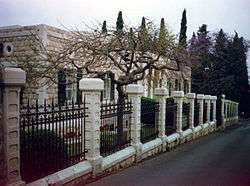Pilgrim House
The term Pilgrim House is a term used by Bahá'ís to signify buildings where pilgrims are (or were) greeted and housed during pilgrimage to the Bahá'í holy places.
There have been numerous buildings within Haifa, Israel dedicated to this, including 4 Haparsim Street (the original Western Pilgrim House), 10 Haparsim Street (the second Western Pilgrim House), the Haifa Pilgrim House (also known as the Eastern Pilgrim House), and the Pilgrim Reception Centre.
Another pilgrim house is located at Bahjí, near the Shrine of Bahá'u'lláh.
Original Western Pilgrim House
The original Western Pilgrim House, located at 4 Haparsim Street in Haifa, Israel, was used a Pilgrim House for members of the Bahá'í Faith of Western origin who had come for pilgrimage during the early years of the 20th century, before it was replaced by 10 Haparsim Street.
The house is currently part of the Bahá'í World Centre. While it was originally rented to serve as a Pilgrim House, the house was then bought by `Abdu'l-Bahá. After being replaced by new Western Pilgrim House, the site was then used by members of the Bahá'í holy family. It left Bahá'í hands shortly before being re-bought by the Universal House of Justice.
It was at 4 Haparsim Street that Shoghi Effendi gave Mary Maxwell, who he would later marry, the title Amatu'l-Bahá Rúhíyyih Khanum. It is now a pilgrimage site for Bahá'ís.
Second Western Pilgrim House

The second Western Pilgrim House, often referred to as "the old western pilgrim house", located at 10 Haparsim Street in Haifa, Israel, was used a Pilgrim House for members of the Bahá'í Faith who had come for pilgrimage during the first half of the 20th century. It is currently part of the Bahá'í World Centre and used by the Bahá'í International Community Secretariat and related offices.
The house was originally paid for by Amelia Collins, a wealthy American Bahá'í, who felt the facilities of the previous Westerner's pilgrim house at 4 Haparsim were inadequate. Its construction was started under the instruction of `Abdu'l-Bahá, but was only completed during the time that Shoghi Effendi was the head of the Bahá'í Faith. Although it served originally as the Pilgrim house for the westerners, it has been used for other purposes more recently:
- From 1951 to 1963 it housed the International Bahá'í Council
- From 1963 to 1983 it served as the Seat of the Universal House of Justice
- From 1983 to 2000 it was occupied by the International Teaching Centre
As of 2005, it is currently included in the pilgrimage run by the Bahá'í World Centre
Eastern Pilgrim House

The Eastern Pilgrim House or the "Haifa Pilgrim House" is a Pilgrim House for Bahá'ís when they go on pilgrimage. The house was built after `Abdu'l-Bahá interred the remains of the Báb on Mount Carmel. The construction of this stone building was supervised Mírzá Ja’far Rahmání of 'Ishqábád, who also paid all the expenses. It is known as the "Eastern Pilgrim House", as for decades it housed the Persian pilgrims. After 1951, when the Western Pilgrim House at 10 Haparsim Street became the seat of the International Bahá'í Council, it became the Pilgrim House for all pilgrims. In 1969 the decision was taken to accommodate pilgrims in hotels, so that the Pilgrim House could be converted into a pilgrim centre.
Pilgrim Reception Centre

The Pilgrim Reception Centre or the "Haifa Pilgrim Reception Centre" is the newest Pilgrim Reception Centre for pilgrimage to sites near the Bahá'í World Centre. It is composed of two conjoined buildings, of a historic medical clinic, that have recently been remodeled. In October 2000 this new Reception Centre, which can accommodate up to 500 people, opened.
Reason for separate Western and Eastern Pilgrim Houses
The reasons for having separate Pilgrim Houses for the Western and Eastern Bahá'ís are due to the different cultures of the pilgrim's backgrounds. Examples may include:
- Eastern pilgrims would always remove their shoes before entering any building whereas westerners may not.
- Eastern pilgrims gave a special reverence to `Abdu'l-Bahá whereas westerners did not always understand this.
- The role of women was very different at the turn of the century in the two cultures.
References
- Bahá'í Pilgrimage - 4 Haparsim Street
- Bahá'í Pilgrimage - 10 Haparsim Street
- Bahá'í Pilgrimage - Haifa Pilgrim House
- Bahá'í World News Service: Reception Center opens for Bahá'í pilgrims to the Holy Land